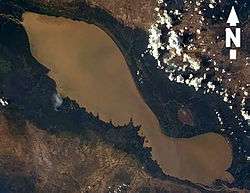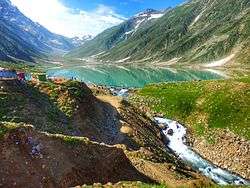List of lakes
For rank-order lists, see List of lakes by area, List of lakes by depth, List of lakes by volume.
Africa
Great Lakes of Africa
- Lake Albert (Mobuto-Sese-Seko)
- Lake Chad
- Lake Edward
- Lake Fianga
- Lake Kariba
- Lake Kivu
- Lake Tana
- Lake Mweru
- Lake Nasser (Lake Nubia in Sudan)
- Lake Nyasa (Lake Malawi)
- Lake Tanganyika
- Lake Turkana (Lake Rudolf or Rudolph)
- Lake Victoria shared between Kenya, Uganda and Tanzania.
- Oguta Lake (Imo State, Nigeria)
See also: Great Lakes of Africa, Rift Valley lakes
Lists by country
Botswana
Cameroon
- Lake Awing
- Lake Bambili
- Lake Bamendjing
- Lake Bankim
- Lake Barombi Mbo
- Lake Edip
- Lake Lagdo
- Lake Mbakaou
- Lake Kendall
- Muanenguba Lakes (Twin Lakes)
- Lake Nyos
- Lake Oku
- Lake Wum
- Lake Monoun
Ghana
Madagascar
- Lake Alaotra
- Lake Bedo
- Lake Itasy
- Lake Ihotry
- Lake Kinkony
- Lake Tritriva
- Lake Tsimanampetsotsa
- Lakes Manambolomaty
Malawi
Mauritania
Mozambique
Nigeria
- Kainji Lake
- Oguta Lake
- Asejire Lake
Sudan
- Roseires Reservoir
- Lake No
- Lake Nubia (southern reaches of Lake Nasser)
Antarctica
There are around 400 lakes under the ice of Antarctica.[1]
Asia
International lakes in Asia
Caspian Sea
The Caspian Sea, located in western Asia on the eastern edges of Europe, is the largest lake on the planet. History records that it is called a sea because the Romans found it salty, especially in the southern reaches, and the name stuck. Oil and natural gas production platforms are replete along the edges of the sea. In addition, large quantities of sturgeon live in its waters, and the caviar produced from their eggs is a valuable commodity. Fresh water flows into the sea via the Volga River and Ural River in the north; however, the sea remains somewhat salty, central and south. The measured surface area is 371,000 sq km (143,244 sq mi), and he maximum depth is at 1025 m (3,363 ft). Additional details and map.
Lake Baikal
Lake Baikal is positioned in southeastern (Siberia) Russia, directly to the north of Mongolia. Recognized as the oldest (still existing) freshwater lake on the planet, it is also measured as the deepest continental body of water at 5,315 feet (1,620 m). In addition, it is the largest freshwater lake by volume, containing an astounding 20% of the planet's fresh water. With a maximum width of 60 miles (96 km), Lake Baikal is about 389 miles (626 km) in length. Completely surrounded by mountains, over 300 rivers and streams drain into this massive lake. Detailed map.
Aral Sea
Positioned in far-western Asia, just to the east of the Caspian Sea, the Aral Sea is located in the countries of Kazakhstan and Uzbekistan. The Aral Sea is disappearing (evaporating) and is today almost totally polluted by fertilizer runoff, weapon testing residue left here by the former Soviet Union and careless industrial projects. The mismanagement of its valuable waters is considered by many experts to be one of the world's worst environmental disasters. Diversion of the Amu Darya and Syr Darya rivers for irrigation began in 1918, and that action, along with other factors have now shrunk the Aral Sea to almost 60% of its former size. Over the last few years the outlook for the northern reaches of the sea have brightened some, but the lower half is basically abandoned and the remaining western waters are now predicted to be gone within a decade. Additional details and map.
Lists by country
Afghanistan
Bangladesh
Cambodia

China
India

Indonesia
Iran
Iraq
- Lake Habbaniyah (Hawr al Habbaniyah)
- Lake Milh (Bahr al Milh)
- Lake Tharthar (Buhayrat ath Tharthar)
- Sawa lake
Kazakhstan
Kyrgyzstan
- Ala-Kul
- Besh-Tash Lake
- Chatyr-Kul
- Issyk Kul
- Jashyl Köl
- Juukuchak Lake
- Kara-Suu Lake
- Kapka Tash Lake
- Kara-Toko Lake
- Kashka-Suu Lake
- Köl-Ükök
- Köl-Suu
- Köl-Tör Lake
- Kulun Lake
- Kylaa-Köl
- Okurgen Lake
- Lake Sary-Chelek
- Merzbacher Lake
- Sary-Köl
- Song Kol Lake
- Tash-Bulak Lake
Malaysia
Nepal
- Fewa Lake
- Rara Lake
- Rupa Lake
- Begnas Lake
- Shey phoksundo lake
- Tilicho Lake
- Gosaikunda Lake
North Korea and South Korea
Pakistan
Syria
- Lake Assad
- Lake Qattinah
- Lake Al-Rastan
- Lake Muzairib
- Zarzar Lake
- Lake Ballouran
Taiwan
Russia
Europe
International lakes in Europe
- Lake Constance (Austria, Germany, Switzerland; Bodensee)
- Dojran Lake (Republic of Macedonia and Greece)
- Lake Geneva (France, Switzerland; Lac Léman)
- Lake Lugano (Switzerland, Italy)
- Lake Maggiore (Switzerland, Italy; Lago Maggiore)
- Lake Neusiedl (Neusiedler See)/Fertő (Austria, Hungary)
- Lake Ohrid (Republic of Macedonia, Albania)
- Lake Peipsi-Pihkva (Estonia, Russia)
- Lake Great Prespa (Albania, Republic of Macedonia, Greece)
- Lake Small Prespa (Albania, Greece)
- Lake Skadar (Montenegro, Albania)
- Lake Vištytis (Lithuania, Russia)
- Lago di Lei (an artificial lake created by a dam; the waters are mostly in Italy but the dam is in Switzerland).
Lists by country
Armenia
Azerbaijan
Cyprus
Hungary
Latvia
Poland
Republic of Albania
Slovakia
Spain
North and Central America
International lakes in North America
Listed in order of occurrence from easternmost border terminus to the westernmost
- Woodland Flowage
- Grand Falls Flowage
- Spednic Lake (part of the Chiputneticook Lakes)
- East Grand Lake (part of the Chiputneticook Lakes)
- North Lake, partly in North Lake Parish, New Brunswick
- Glazier Lake
- Beau Lake
- Lac de l'Est
- Little St. John Lake (Petit lac Saint-Jean)
- Lac Wallace
- Line Pond (Etang Duck)
- Lake Memphremagog a 40-mile-long (64 km) glacial lake that extends from Vermont into Canada
- Lake Champlain in Quebec in Canada and New York and Vermont in the United States
- Lake Ontario in Ontario, Canada; and New York in the US
- Lake Erie in Ontario in Canada and Michigan, New York, Ohio, and Pennsylvania in the US
- Lake St Clair in Ontario, Canada; and Michigan in the US
- Lake Huron in Ontario in Canada and Michigan in the US
- Munuscong Lake
- Lake George
- Lake Superior in Ontario, Canada; and Michigan, Minnesota, and Wisconsin in the US
- South Fowl Lake
- North Fowl Lake
- Moose Lake, entry point into the Boundary Waters Canoe Area Wilderness
- Mountain Lake (Cook County, Minnesota)
- Rose Lake (Pigeon River)
- South Lake
- North Lake
- Gunflint Lake
- Magnetic Lake
- Clove Lake
- Granite Lake in Minnesota, U.S. and Ontario, Canada
- Granite Bay
- Gneiss Lake
- Maraboeuf Lake
- Saganaga Lake
- Swamp Lake
- Ottertrack Lake
- Knife Lake
- Carp Lake in Minnesota, U.S. and Ontario, Canada
- Birch Lake in Minnesota, U.S. and Ontario, Canada
- Sucker Lake
- Basswood Lake
- Wednesday Bay
- Thursday Bay
- Crooked Lake in Minnesota, U.S. and Ontario, Canada
- Sunday Bay
- Bottle Lake
- Lac la Croix
- Loon Lake
- Little Vermillion Lake
- Sand Point Lake
- Rainy Lake
- Lake of the Woods in Minnesota, U.S.; Manitoba and Ontario in Canada
- Wilfred's Lake
- Susie Lake
- Osthus Lake
- South Messier Lake
- Hartley Lake
- Boundary Lake in North Dakota, U.S.; Manitoba, Canada
- Cavalier Lake
- Ross Lake in North Dakota, U.S. and Manitoba, Canada
- Lake Metigoshe
- Bone Lake
- Line Lake
- Brush Lake in North Dakota, U.S. and Saskatchewan, Canada
- Salt Lake in northeastern Montana, USA; known as Alkali Lake in Saskatchewan, Canada
- Upper Waterton Lake in Alberta, Canada; and Montana, U.S.
- Cameron Lake in Alberta, Canada; and Montana, U.S.
- Frozen Lake
- Lake Koocanusa
- Alden Lake
- Osoyoos Lake
- Ross Lake in Washington, U.S. and British Columbia, Canada
Lists by country
El Salvador
- Lago de Coatepeque (Coatepeque Lake)
- Lago De Ilopango (Ilopango Lake)
- Laguna De Güija (Güija Lake)
- Laguna Verde
- Laguna de Alegria
- Olomega Lake
- Suchitlan Lake
Honduras
Nicaragua
- Lake Apanás
- Lake Nicaragua (Lake Cocibolca)
- Lake Managua
- Laguna de Apoyo
Panama
USA
- Lake Michigan
- Great Salt Lake
- the great lakes:Lake Superior, Lake Huron, Lake Michigan, Lake Erie.
Oceania
Lists by country
Australia
New Zealand
Papua New Guinea
South America
International lakes in South America
- Lake Titicaca (in Peru and Bolivia)
- General Carrera Lake (in Chile and Argentina)
- O'Higgins/San Martín Lake (in Chile and Argentina)
- Cochrane/Pueyrredón Lake (in Chile and Argentina)
- Cami/Fagnano Lake (in Chile and Argentina)
- Palena/General Vintter Lake (in Chile and Argentina)
- Lake Viedma (undefined border near the Southern Patagonian Ice Field between Chile and Argentina)
Lists by country
Peru
Suriname
Venezuela
- Guri (man-made)
- Lake Maracaibo (sometimes considered a sea)
- Lake Valencia
Former lakes
Extraterrestrial Lakes
Titan
See also
| Wikimedia Commons has media related to Lakes. |
- List of lakes by area
- List of lakes by depth
- List of lakes by volume
- List of lakes named after people
- Portal:Contents/Lists of topics
References
- ↑ See map in Peter Aldhous (Aug 23, 2014). "First samples of Antarctic lake reveal thriving life". New Scientist: 12. Archived from the original on August 23, 2014.
- ↑ "25th highest lake in the world".

